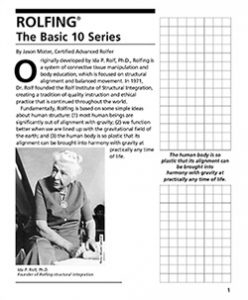“If you can imagine how it feels to live in a fluid, light, balanced body, free of pain, stiffness and chronic stress, at ease with itself and the Earth’s gravitational field; then you will understand the goals of Rolfing®” -Ida Rolf
Rolfing® is a holistic system of soft tissue manipulation and movement education which releases chronic stress/tension patterns and restores the body to its healthiest and most efficient alignment. By lengthening and repositioning the connective tissue (muscles, tendons, ligaments, etc.), Rolfing works to establish changes in the body’s overall structure and restore the body to a more balanced state.
Benefits Include:
- Relief from Chronic Stress, Tension and Pain, including: neck & shoulder pain, back pain, headaches, joint restrictions, hip problems, Sciatica, Carpal Tunnel, TMJ, Plantar Fasciitis, tendonitis, and Tennis Elbow
- Increased Energy and Sense of Well Being
- Better Posture and Flexibility
- Better Coordination and Balance
- Improved Athletic Performance
- Enhanced Recovery from Injuries and Trauma
- Psychological and Emotional Growth
- Greater Body Awareness
How does Rolfing® work?
Fascia or connective tissue completely surrounds every joint, muscle, bone and organ and it gives shape and strength to our body. Hardened or shortened areas in this fascial web are caused by repeated patterns of use such as the way we walk, sit, stand or sleep as well as deep-seated emotional patterns. When fascia is healthy, it’s smooth coating permits neighboring structures to slide over one another. However, following inflammatory response or traumatic illness, manifestation of poor posture or emotional stress, or simply ongoing time may alter function and form. Layers adhere to one another and may become ‘glued’ together. They will no longer slide and work as they should, making the body work a lot harder to function; contributing to weariness and tension. Imbalances in the fascia occur where the stress is greatest, negatively affecting our body’s shape and movement patterns. You may begin to feel less flexible and less able to move freely as you once did. Pain is often the result. Rolfing works to release these holding patterns and to restore movement, function, and alignment.
How many sessions of Rolfing® do I need?
Rolfing is usually done in a series of 10 sessions (Additional sessions are sometimes recommended when chronic problems exist) in order for the Rolfer to fully address the entire body, but clients can come for fewer sessions. A series of 3 sessions will generally provide the Rolfer and client with enough information to determine if Rolfing is right for the client and address isolated concerns, but they are welcome to try one session as well. This can still be very beneficial in isolation yet will not be detrimental to the client. Obviously, the full potential of Rolfing won’t be realized until a full series is conducted.
How often should I come?
Most people find once a week to be a beneficial and convenient time frame. However, others may find that they need more time between sessions. It is recommended that the client not receive more than 2 sessions per week as this might be too much work for the body to comfortably assimilate.
Does Rolfing® last?
Yes. Changes from the basic series are still present many years after the series is complete. On the other hand, as bodies change, and people have further injuries, accidents or stressful times, additional work may be useful. My colleague, Don Bruce coined the phrase: ‘Rolfing®, bodywork that lasts a lifetime.’
Does Rolfing® hurt?
Rolfing had a reputation of being painful years ago, but over the years it has been modified to work within the client’s comfort zone. Sensitivity of the practitioner has had the most integral impact. Most clients report the majority of the sensations during a typical session to be either pleasurable or neutral. If a client is experiencing discomfort, the Rolfer will simply slow the work down to enable the client to receive the work in a more comfortable manner. The ultimate goal is for the muscles to release and relax.
Can children receive Rolfing®?
Absolutely. In addition to correcting structural patterns, Rolfing® can serve as a preventative measure to reverse potentially problematic patterns in children. Some of the childhood structural patterns that respond well to Rolfing are scoliosis, pigeon toes, knocked-knees, rounded legs, poor posture, and even general adolescent growing pains. The work will usually be very effective since children won’t have as many years of “poor bodily patterns” to work against. The sessions with children are always gentle and comfortable and rarely require as much time as an adult body might require. Usually a full series of ten or more sessions isn’t performed until the teenage years.
How is Rolfing® different than Chiropractic?
Traditional Chiropractic has had its focus on bones and the skeletal system and typically uses high velocity thrusting methods. However, unless the tension and strain in the soft tissue (fascia, muscles, tendons, and ligaments) is addressed, the bones will continue to be pulled out of alignment. Rolfing, on the other hand, involves slower sustained pressures and addresses the entire bed of soft tissue in which the bones are embedded. The goal is to achieve balanced tension, which allows the bones to fall back into their proper relationships naturally. Our experience is that Chiropractic and Rolfing can work well together and are complementary disciplines.
How is Rolfing® Different than Massage?
Although at times Rolfing and Massage may feel similar they differ in both the goals and the results. The Rolfer will create a strategy for the sessions to permanently change the client’s structure to function better within gravity and educate the client to use their bodies in a more efficient manner. The client will also be much more active in a Rolfing session, as they will be asked to perform specific movements to assist with the Rolfing process. Generally, there will be less strategy in a massage session and more emphasis on releasing individual muscles opposed to re-balancing the body as a whole. During a Rolfing session the client may be asked to briefly stand and walk to experience and embody the shifts that occur.
What should I wear?
Women can wear either a bra and shorts, 2 piece bathing suit, or bra and underwear. Men can wear their regular underwear. The sessions are usually started with a brief structural analysis, as long as the client is comfortable with that. While on the table, the client is draped just as they would be during a massage session.
The Sessions
Rolfing® is about appropriate relationships. The body naturally compensates for all experiences in life. This is called Body Intelligence. The work of the 10 sessions is to get all systems communicating harmoniously again. The weight of the body is “held up” by the skeletal structure. The opposing force is gravity- related to the upright nature of man. With applied pressure, movement and breathing, the body can be reorganized and restructured around what we call “the line of the spine”. There is a restacking of the blocks. (This is conveyed in the official trademarked symbol of Rolfing®, the ‘little boy logo’.) This work is for those who want to open to change and potential, are seeking release from their contracted state, and want to create order out of chaos.
The first three sessions work through the superficial layers or ‘body stocking’ of the body.
Session 1 focuses on creating a “breathing” thorax by loosening the rib cage. Shoulders, chest, lower back, & pelvis are addressed. The sleeves of the legs and arms are also freed.
Session 2 is for laying a “good and stable foundation” for the whole body structure. Work is concentrated on the area from the feet to the knees. A goal of this session is to feel weight distributed evenly between the feet.
Session 3 opens up the sidelines of the body: From the head & neck all the way down to the toes. This session gives you the feeling of being put together, of resting more comfortably on Earth, and having a more elongated body.
Sessions 4, 5 and 6 are best done in succession because of all the internal working together of the inner legs, abdomen, and pelvic girdle.
Session four concentrates on the inner thigh leg, connections to the pelvis, and the deep inner workings of the abdomen.
Session five is swimming through the layers of the abdominal cavity – superficial to deep. The entire “ocean” is covered, and a complete circle is made from just below the rib cage, down to the pubic bone and back up. By increasing mobility in the pelvis, balance & congruence are created for the spinal column.
Session six focuses on the back or posterior side from heels to head. Loosening of the pelvis in these three sessions helps to free the sacrum or “seat of the soul” – & thus move trapped energy which may not have been able to circulate.
Session 7 releases the head and neck and aligns it with the rest of the body, all the way to the ground. All parts of the body now become centered around the “core” line of the spine. This session is generally where most people feel like the light bulb comes on!
Session 8 and 9 are “the balancing sessions.” A simple test is administered to evaluate which work is needed first, the upper or lower. Whichever one comes first, is Session eight, and the latter, Session nine. The goal is to bring your body to the next highest level of order possible. Session 10 is integration of the whole being through final balancing. This is a fine- tuning of relationships between body segments. The effects of a Rolfing series will then continue to mature for an additional 6-12 months as your body undergoes it’s own unique adjustment process to the changes initiated by Rolfing.
The following pictures are examples of how Rolfing® impacted & changed the posture of these individuals. Experiences vary greatly from person to person, but most report positive results.
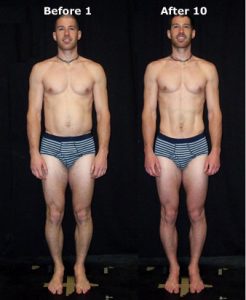
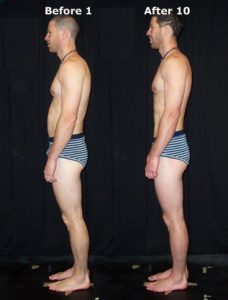
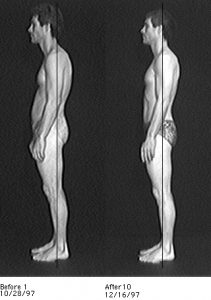
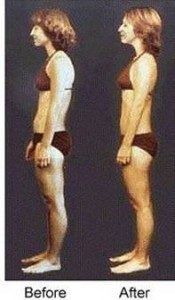
Please call us today for a treatment.

